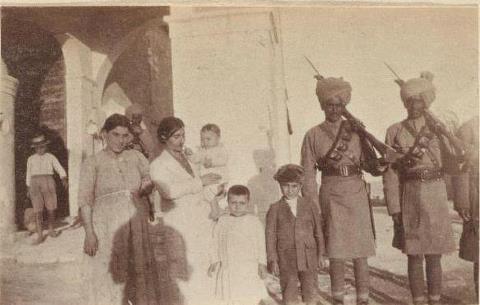Shared Sorrows: Indians and Armenians in the prison camps of Ras al-‘Ain, 1916-18 – 18
On November 26th Sisir and his comrades reached Tripoli; and on December 4th they embarked on a ship that took them to Port Said.
But before they could embark, there ensued one of the strangest episodes in this story. At the centre of it was one of the BAC’s ‘camp-followers’, a sweeper called Jumman. It’s best that Sisir tells the story himself:

‘When we were marching [northwards] from Mosul, Jumman saw an Armernian child on the banks of a stream near Ras al-‘Ain and picked him up. His mother must have died, and his father must have been killed… Jumman took on the responsibility of looking after the boy and named him Babulal. He used to call Jumman father (‘Baba’).’ (p.175)[i]
This story would be hard to believe if it were not confirmed by other sources. But E.A. Walker, an English oficer, came upon a group of ‘Indian sepoy prisoners in a holding camp at Ras-el-Ain’ in 1916. He noted in his diary, which is now in the Imperial War Museum, that they ‘had with them a ‘small Armenian boy of about ten or so’ who was the sole survivor of thousands of Armenian women and children who had been massacred.’’[ii]
Sisir notes that Babulal soon began to speak Hindi and that once he was old enough he began to work as a fifer for the Bengal Ambulance Corps [iii]. This was a job that by long tradition of British Indian army, had been performed by orphaned Eurasian boys – so the tale is not as unlikely as it may sound.
But at Tripoli a problem arose: ‘Before embarking on the ship to Suez Jumman was told that he would not be allowed to bring Babulal with him. An Armenian padre came to take Babulal away. But why would Babulal go to him? He made a huge fuss and cried up a storm of tears; and Jumman wept too, holding on to the boy. In the end Jumman was allowed to take Babulal home with him.’ (p.175)
Babulal, Jumman, Sisir and their surviving comrades reached India on January 8th, 1919.
_________________________________________________________
[i] In the text this story is told out of chronological sequence.
[ii] Heather Jones, op. cit. I am very grateful to Santanu Das for bringing this reference to my attention. The catalogue number of E.A.Walker’s diary is: IWM 76/115/1 Diary of E.A.Walker, 17/7/16.
[iii] In the British Indian Army, by long tradition, fifers and drummers were recruited from orphanages for Eurasians. The recruits were often children.
* Photograph courtesy the Armenian Genocide Museum, Yerevan, Armenia (thanks to Anna Aleksanyan). The picture did not have a title as such but I was told that it was of Indian sepoys with Armenian widows and orphans in 1917-18 period. Unfortunately I was unable, for technical reasons, to post another picture from their collection with the title ‘Young Armenian Orphans Rescued by Indian Officers’.

Dear Mr. Ghosh,
I am, like millions, a fan your work. I have been working on a history of the Armenians in India from the 18th to the middle of the 20th century. In Kolkata I have interviewed Armenians whose grand parents survived the genocide and made it to India, but I do not have any photograph. I shall be grateful if I am allowed to use this photograph.
The link to the website shows the name of the director of my institute; but the project is mine
With kind regards,
Bhaswati Bhattacharya
I’m afraid I don’t know which picture you are referring to. Most of the pictures in this series were from the archive of the Genocide Museum in Yerevan. You should probably write to them.
I wish you all success with your project.
Amitav Ghosh